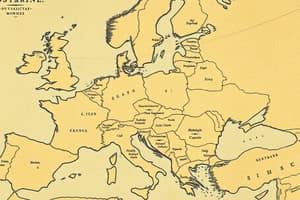Podcast
Questions and Answers
What is the primary purpose of excavation in the context of the medieval settlement?
What is the primary purpose of excavation in the context of the medieval settlement?
- To build new settlements
- To cultivate the land
- To destroy existing structures
- To uncover historical remains (correct)
Which term describes the efforts made to protect and maintain discovered artifacts?
Which term describes the efforts made to protect and maintain discovered artifacts?
- Preservation (correct)
- Artefacting
- Restoration
- Excavation
What do the ruins of the medieval settlement represent?
What do the ruins of the medieval settlement represent?
- An area for current habitation
- A modern city with new developments
- The remnants of a long-gone civilization (correct)
- A historical museum for artifacts
Which of the following terms refers to a preserved remnant of a prehistoric creature?
Which of the following terms refers to a preserved remnant of a prehistoric creature?
What is indicated by the term 'landmark' in the context of the medieval settlement?
What is indicated by the term 'landmark' in the context of the medieval settlement?
The process of repairing and stabilizing artifacts and ruins is known as what?
The process of repairing and stabilizing artifacts and ruins is known as what?
What does the term 'civilization' refer to in this context?
What does the term 'civilization' refer to in this context?
What significant aspect does a shipwreck provide in the context of the medieval settlement?
What significant aspect does a shipwreck provide in the context of the medieval settlement?
What was likely used in daily life by the inhabitants of the settlement?
What was likely used in daily life by the inhabitants of the settlement?
Which feature of the old castle provides insight into its architectural style?
Which feature of the old castle provides insight into its architectural style?
Which of these professions was NOT mentioned as being part of the team involved in the excavation?
Which of these professions was NOT mentioned as being part of the team involved in the excavation?
What significant discovery near the settlement provided insight into the community’s interactions with the natural world?
What significant discovery near the settlement provided insight into the community’s interactions with the natural world?
What did the archaeologists aim to uncover at the ancient site?
What did the archaeologists aim to uncover at the ancient site?
What signifies that the area was previously inhabited before becoming ruins?
What signifies that the area was previously inhabited before becoming ruins?
What did the shipwreck discovery indicate about the medieval settlement?
What did the shipwreck discovery indicate about the medieval settlement?
What term is used to refer to the site after significant discoveries were made?
What term is used to refer to the site after significant discoveries were made?
How did the local community respond to the excavation efforts?
How did the local community respond to the excavation efforts?
What method was used to preserve the artefacts found at the excavation site?
What method was used to preserve the artefacts found at the excavation site?
What type of evidence did the rare discovery near the settlement represent?
What type of evidence did the rare discovery near the settlement represent?
What was critical for the discovered artifacts to avoid damage?
What was critical for the discovered artifacts to avoid damage?
What aspect of the settlement's builders demonstrated their advancement?
What aspect of the settlement's builders demonstrated their advancement?
What type of professionals made up the excavation team?
What type of professionals made up the excavation team?
What kind of artefacts were discovered at the settlement site?
What kind of artefacts were discovered at the settlement site?
What was revealed alongside the excavation of the settlement?
What was revealed alongside the excavation of the settlement?
What did the well-preserved fossil found at the site provide?
What did the well-preserved fossil found at the site provide?
How did the local community respond to the excavation site?
How did the local community respond to the excavation site?
What preservation efforts were planned for the artefacts and fossils uncovered?
What preservation efforts were planned for the artefacts and fossils uncovered?
What aspect of the shipwreck contributed to its historical significance?
What aspect of the shipwreck contributed to its historical significance?
What was discovered as a result of the excavation process?
What was discovered as a result of the excavation process?
Flashcards are hidden until you start studying
Study Notes
Excavation of the Medieval Settlement
- Excavation took place in a remote countryside, revealing the remnants of a forgotten medieval settlement.
- The settlement was previously vibrant but had become a field of ruins.
- The excavation team comprised experienced archaeologists and paleontologists uncovering significant layers of soil.
Discoveries Unearthed
- Numerous artefacts, including pottery and tools, were found, each contributing to understanding the settlement's past.
- A well-preserved fossil was discovered, providing insights into the prehistoric life that existed before the settlement.
- Near the ruins, the remains of an ancient shipwreck were found, indicating trade routes and maritime activity of the time.
Significance of the Site
- The excavation site gained recognition as a historical landmark due to the important discoveries made.
- Scholars and enthusiasts from around the world visited, bridging the gap between present and ancient times for the local community.
- Plans were initiated to create a museum to preserve and share the findings with future generations.
Preservation and Restoration Efforts
- Efforts were made to stabilize and preserve the ruins and artefacts, ensuring their survival for future study.
- The restoration process included cleaning, cataloging, and carefully studying the artefacts.
Key Vocabulary
- Excavation: The meticulous process of uncovering historical remains.
- Fossil: A preserved remnant that provides context for natural history.
- Landmark: A site recognized for its historical significance after major finds.
- Ruins: The remnants of structures from the medieval settlement.
- Shipwreck: Remains of an ancient vessel revealing clues about trade.
- Preservation: Efforts focused on maintaining and safeguarding discoveries.
- Restoration: The process of repairing and stabilizing historical remains.
- Civilization: The culture and society of the people who once thrived in the settlement.
- Paleontology: Science concerned with studying fossils from the excavation.
Community Involvement
- The local community expressed pride in the excavation, viewing it as a link to their historical roots.
- Engagement in preservation activities fosters an appreciation for their ancestral heritage.
Historical Context
- The discoveries shed light on the sophisticated agricultural and trade practices of the medieval civilization.
- The excavation not only contributes to historical knowledge but also revives interest in the area’s past.
Studying That Suits You
Use AI to generate personalized quizzes and flashcards to suit your learning preferences.




